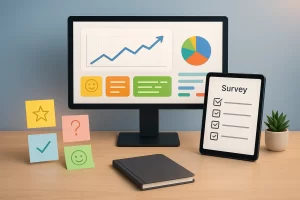12 Effective Debt Management Strategies from Real-World Experiences
Effective debt management is crucial for financial stability and growth. This article presents proven strategies drawn from real-world experiences and expert insights. Discover practical approaches to tackle debt and improve your financial health.
- Snowball Method Builds Momentum and Confidence
- Align Debt Repayment with Revenue Cycles
- Snowball Method Delivers Quick Psychological Wins
- Automate Payments for Consistent Debt Reduction
- Proactive Cash Flow Forecasting Prevents Reactive Borrowing
- Prioritize High-Interest Balances for Effective Repayment
- Purpose-Prioritized Stacking Protects Core Business Mission
- Avalanche Method Reduces Interest and Improves Flexibility
- Generate Positive Return on Every Dollar
- Cash Flow-First Approach Ensures Stable Finances
- Line-Item Budgeting with Zero Balance Method
- Map Income Against Obligations to Tackle Debt
Snowball Method Builds Momentum and Confidence
One strategy I use to manage debt effectively is the debt snowball method—paying off the smallest debts first while making minimum payments on the rest. Each time a debt is paid off, I roll that payment into the next-smallest balance. This creates momentum and a clear sense of progress.
My experience with this method was not only financial but also psychological. Early wins gave me the motivation to stay disciplined, even when progress on larger debts was slower. It felt empowering to see accounts close one by one, and that emotional boost helped me stick to my budget and resist new debt.
The snowball method might not be the most mathematically efficient (compared to the debt avalanche method, which targets high-interest debt first), but for me, behavioral wins beat theoretical savings. It helped me build confidence and consistency—two key ingredients in becoming and staying debt-free.
 Lyle Solomon
Lyle Solomon
Principal Attorney, Oak View Law Group
Align Debt Repayment with Revenue Cycles
One strategy I always come back to is structuring debt with a clear revenue-aligned repayment model—essentially tying repayment schedules to cash flow rather than fixed timelines. I first applied this with a startup that had seasonal revenue spikes. Rather than locking them into a rigid monthly repayment plan, we negotiated terms that flexed with their earnings. It reduced stress on the founders, improved compliance, and ultimately made the investors more confident too because it demonstrated thoughtful risk mitigation.
We’ve used a similar principle when guiding clients preparing for bridge rounds; we look at upcoming liquidity events or expected revenue surges and align short-term obligations accordingly. I’ve found that this approach not only keeps operations fluid but also strengthens relationships with lenders—transparency and flexibility often lead to better terms. It’s not glamorous, but it’s incredibly effective when cash is tight and predictability is low.
 Niclas Schlopsna
Niclas Schlopsna
Managing Consultant and CEO, spectup
Snowball Method Delivers Quick Psychological Wins
The snowball method is a well-known debt repayment approach that focuses on clearing the smallest debt first while maintaining minimum payments on all other accounts. Once the smallest balance is eliminated, the payment amount previously used for that debt is added to the next smallest, creating a snowball effect as more funds become available for each subsequent debt. This strategy does not consider interest rates, instead prioritizing the psychological benefit of quick wins, which can boost motivation and encourage continued progress toward becoming debt-free. Many find that seeing debts disappear one at a time helps maintain momentum, even if this strategy may not always result in the lowest total interest paid over the repayment period. Regularly reviewing debts and updating payment amounts as each balance is cleared supports ongoing progress and helps build a sense of financial control.
 Richard Dalder
Richard Dalder
Business Development Manager, Tradervue
Automate Payments for Consistent Debt Reduction
Managing debt isn’t just about paying bills; it’s about keeping control when things feel out of control. Most of us know that debt can pile up fast, especially when life throws surprises: a car breaks down, work slows, or prices just creep higher. What we don’t always know is how to keep that debt from turning into something that chokes your choices. Over the years, I’ve seen one strategy work again and again—not glamorous, but powerful—automating your payments and pairing it with a “pay yourself second” rule.
Here’s what that looks like. Instead of hoping to pay down debt with what’s left over each month, I flip the script. I set up automatic transfers to knock out specific amounts, just like any other bill. Think of it like brushing your teeth. You don’t debate whether to do it; you just do. This removes willpower from the equation. At the same time, I allow a little space for spending first. That might sound backward, but if you budget a small, guilt-free amount to enjoy dinner out or a short trip, you’re more likely to stick with the plan long-term. Strict budgets often snap.
This became even more important during the pandemic. People who relied on memory or monthly guesswork often missed payments, racked up fees, or lost track. But those with systems—automated payments, even small ones—stayed more grounded. It’s the difference between trying to hold your breath through tough months versus building a rhythm that helps you breathe through them. If the economy shifts, or rates climb, your strategy still holds. You just adjust the number, not the habit.
Let’s make this real. Say your credit card balance is weighing on you. You automate $150 a month toward it, timed with payday. You also give yourself $50 to enjoy however you like—no guilt. You may not pay off everything in six months, but you avoid missing payments and keep the momentum going. If your income drops, you dial back to $75. You still move forward, just slower.
Having a consistent system beats waiting for a perfect plan. Debt doesn’t need to run your life. A simple shift like setting rules that remove daily decisions can change how you feel about money, stress, and even your future.
 Justin Abrams
Justin Abrams
Founder & CEO, Aryo Consulting Group
Proactive Cash Flow Forecasting Prevents Reactive Borrowing
One strategy that has proven effective in managing debt is prioritizing proactive cash flow forecasting combined with vendor and creditor communication. By maintaining clear visibility into receivables and outflows over 60 to 90 days, it’s easier to identify potential liquidity crunches and act early—whether that means renegotiating payment terms or temporarily adjusting expenditure. In practice, this approach has helped avoid reactive borrowing and maintain credibility with financial partners. It also enables a more strategic deployment of capital toward growth areas instead of scrambling to cover shortfalls, which can snowball into larger debt cycles.
 Anupa Rongala
Anupa Rongala
CEO, Invensis Technologies
Prioritize High-Interest Balances for Effective Repayment
As a mortgage professional with years of experience guiding clients through complex financial decisions, I’ve seen firsthand how overwhelming debt can be. One strategy I consistently recommend—and use myself—is the “Debt Snowball Method.” It’s a simple, psychology-based approach that builds momentum and confidence, helping people stay motivated as they work toward becoming debt-free.
The Debt Snowball Method involves paying off debts from the smallest balance to the largest, regardless of interest rates. You make minimum payments on all your debts but put any extra money toward the one with the lowest balance. Once that’s paid off, you roll its payment into the next-smallest debt, and so on—like a snowball gaining size and speed.
From a psychological standpoint, the biggest hurdle in managing debt is often motivation. The snowball method delivers quick wins, which can help build the emotional momentum needed to stick with a plan. According to a 2022 study from the Harvard Business Review, people using this method were significantly more likely to stick to their debt repayment plans than those focusing solely on interest rates.
When I started my own journey with student loans and a car payment, I was tempted to tackle the highest-interest loan first. But after struggling to stay motivated, I switched to the snowball method. Paying off that first small balance gave me a huge sense of accomplishment—and that positive feeling fueled my drive to keep going.
Many of my clients have had similar experiences. It’s not just about math—it’s about behavior. That’s why this strategy often proves more successful over time.
Managing debt isn’t easy, but the right strategy can make a big difference. The Debt Snowball Method isn’t perfect for everyone—especially if you’re carrying high-interest debt—but it can be incredibly effective for building momentum and confidence. If you’re feeling stuck, give it a try. And if you’re looking for more personalized guidance on improving your financial health, reach out—we’re here to help you take the next step with confidence.
 Samantha Shelton
Samantha Shelton
Owner/Founder, Align Lending
Purpose-Prioritized Stacking Protects Core Business Mission
An effective strategy to manage debt involves creating a clear repayment plan that prioritizes high-interest balances first. This approach reduces the overall cost of debt over time and prevents smaller obligations from snowballing into bigger problems. In my experience, applying this method requires discipline and ongoing monitoring, similar to how I advise clients to continuously review their email security posture. Both processes benefit from breaking down complex challenges into manageable steps and focusing on steady progress.
I’ve seen this strategy work well when paired with realistic budgeting and regular adjustments. Just as cyber threats evolve and demand updated defenses, personal finances also require frequent reassessment to stay on track. Clients who commit to a structured repayment timeline often regain financial control faster, which parallels how businesses regain confidence after implementing targeted cybersecurity measures. The key is consistency and making informed decisions based on clear priorities.
This method also helps reduce stress and uncertainty, much like simplifying email security helps clients feel more secure. Debt can feel overwhelming without a plan, just as email fraud can cause confusion without expert guidance. Establishing a straightforward strategy creates clarity, allowing individuals or organizations to focus on long-term stability rather than short-term anxiety. Overall, disciplined, prioritized repayment offers a practical path to managing debt effectively.
 Ben Rasmussen
Ben Rasmussen
Advisor, Email Guard
Avalanche Method Reduces Interest and Improves Flexibility
When we first opened, debt management wasn’t optional—it was survival. Like most entrepreneurs in healthcare, we didn’t start with unlimited capital or big investors. We started with a mission. But purpose doesn’t pay the bills, and treatment centers have heavy upfront costs: licensing, staffing, insurance, facility compliance, equipment, marketing.
One strategy that’s worked for us—and that I’d recommend to any business owner—is what I call “purpose-prioritized stacking.” Instead of paying down debt evenly across the board, we prioritize based on what protects the core mission of the business first. High-interest credit? Obviously. But beyond that—if paying off a loan tomorrow would force us to cut clinical staff or reduce care quality, we hold the line. If servicing debt means we can’t invest in outcomes tracking or alumni programming that prevents relapse, we restructure.
In practice, that’s meant renegotiating terms, consolidating where possible, and building disciplined reserves before accelerating debt paydown. It’s not flashy, and it doesn’t always make your balance sheet look the prettiest in the short term—but it protects what matters most: the integrity of care.
My experience? Debt can be a tool or a trap. The key is staying ruthlessly clear on what drives the mission and what doesn’t. For us, repayment schedules will never take priority over patient outcomes. That mindset has kept us solvent and growing—without sacrificing what brought us into this work in the first place.
 Andy Danec
Andy Danec
Owner, Ridgeline Recovery LLC
Generate Positive Return on Every Dollar
One strategy I’ve found particularly effective in managing debt is maintaining a clear prioritization framework—essentially, I categorize debts by interest rate and impact on cash flow, then focus on paying down the highest-cost liabilities first. This “avalanche” method helps reduce overall interest expenses and frees up cash more quickly.
Applying this approach has been invaluable, especially when managing financing for growth initiatives or operational expenses. It keeps our financial structure lean and flexible, allowing us to respond swiftly to new opportunities without being overburdened by costly debt. Over time, this disciplined focus on managing and reducing high-interest debt has strengthened our balance sheet and improved investor confidence.
The key, in my experience, is consistent monitoring and disciplined repayment rather than letting debts accumulate or deferring payments. It’s a simple principle, but one that requires commitment and clear visibility into all outstanding obligations.
 Andrew Izrailo
Andrew Izrailo
Senior Corporate and Fiduciary Manager, Astra Trust
Cash Flow-First Approach Ensures Stable Finances
I look at debt the same way I look at a high-stakes media buy. The goal is not just to manage it or pay it down. The goal is to generate a clear, positive return on every single dollar. We manage hundreds of millions in ad spend, and if a campaign is not producing a profitable return, we terminate it immediately. Debt should be treated with the same ruthless discipline. It is a tool for growth, but only if the capital is deployed into channels that generate more revenue than the cost of the debt itself.
Many businesses get this wrong. They take on debt for a vague purpose like “growth” without the systems to track the specific ROI of that capital. They let underperforming, debt-fueled projects run for far too long. You need to have the same kill-switch mentality for your debt strategies as you do for your ad campaigns. If it is not working, cut the liability and reallocate the resources to something that is.
 Maxwell Finn
Maxwell Finn
Founder, Unicorn Innovations
Line-Item Budgeting with Zero Balance Method
One strategy that has worked well for me is the cash flow-first approach—prioritizing debt repayments around actual monthly revenue rather than fixed percentages. In our agency’s early years, I resisted the urge to clear debt aggressively during good months. Instead, we built a three-month buffer first, then tackled debt with structured payments. This kept us stable during quiet quarters without sliding into panic mode. The result? Predictable finances and better vendor relationships because we always paid on time. Debt management isn’t just about speed—it’s about consistency.
 Eugene Leow Zhao Wei
Eugene Leow Zhao Wei
Director, Marketing Agency Singapore
Map Income Against Obligations to Tackle Debt
As an SEO Manager juggling projects and retainers, I treat debt like a high-priority client: loud, persistent, and always needing attention. My go-to strategy? Line-item budgeting paired with the “zero balance” method. Every cent gets an assignment. No freeloaders.
I once ignored this and let small expenses pile up: subscriptions, impulse buys, random upgrades. Next thing I knew, I was stuck paying off nonsense. Now, I map income against actual obligations and redirect extra funds to the highest-interest debt. Simple, boring, but effective.
What made it stick for me was tracking my emotional spending triggers. Stress equals spending. Knowing that helped me shift from reacting to planning. Think of it like SEO: you don’t wing it and hope rankings magically improve. You work the plan.
Debt’s no different. Have a plan. Stick to it. Adjust when needed. Just don’t ghost it; it’ll chase you down like a bad backlink.
 Nick Mikhalenkov
Nick Mikhalenkov
SEO Manager, Nine Peaks Media







































